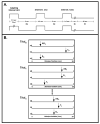Vibrotactile adaptation fails to enhance spatial localization in adults with autism
- PMID: 17498672
- PMCID: PMC1987714
- DOI: 10.1016/j.brainres.2007.04.032
Vibrotactile adaptation fails to enhance spatial localization in adults with autism
Abstract
A recent study [Tannan, V., Tommerdahl, M., Whitsel, B.L., 2006. Vibrotactile adaptation enhances spatial localization. Brain Res. 1102(1), 109-116 (Aug 2)] showed that pre-exposure of a skin region to a 5 s 25 Hz flutter stimulus ("adaptation") results in an approximately 2-fold improvement in the ability of neurologically healthy human adults to localize mechanical stimulation delivered to the same skin region that received the adapting stimulation. Tannan et al. [Tannan, V., Tommerdahl, M., Whitsel, B.L., 2006. Vibrotactile adaptation enhances spatial localization. Brain Res. 1102(1), 109-116 (Aug 2)] proposed that tactile spatial discriminative performance is improved following adaptation because adaptation is accompanied by an increase in the spatial contrast in the response of contralateral primary somatosensory cortex (SI) to mechanical skin stimulation--an effect identified in previous imaging studies of SI cortex in anesthetized non-human primates [e.g., Simons, S.B., Tannan, V., Chiu, J., Favorov, O.V., Whitsel, B.L., Tommerdahl, M, 2005. Amplitude-dependency of response of SI cortex to flutter stimulation. BMC Neurosci. 6(1), 43 (Jun 21) ; Tommerdahl, M., Favorov, O.V., Whitsel, B.L., 2002. Optical imaging of intrinsic signals in somatosensory cortex. Behav. Brain Res. 135, 83-91; Whitsel, B.L., Favorov, O.V., Tommerdahl, M., Diamond, M., Juliano, S., Kelly, D., 1989. Dynamic processes govern the somatosensory cortical response to natural stimulation. In: Lund, J.S., (Ed.), Sensory Processing in the Mammalian Brain. Oxford Univ. Press, New York, 79-107]. In the experiments described in this report, a paradigm identical to that employed previously by Tannan et al. [Tannan, V., Tommerdahl, M., Whitsel, B.L., 2006. Vibrotactile adaptation enhances spatial localization. Brain Res. 1102(1), 109-116 (Aug 2)] was used to study adults with autism. The results demonstrate that although cutaneous localization performance of adults with autism is significantly better than the performance of control subjects when the period of adapting stimulation is short (i.e., 0.5 s), tactile spatial discriminative capacity remained unaltered in the same subjects when the duration of adapting stimulation was increased (to 5 s). Both the failure of prior history of tactile stimulation to alter tactile spatial localization in adults with autism, and the better-than-normal tactile localization performance of adults with autism when the period of adaptation is short are concluded to be attributable to the deficient cerebral cortical GABAergic inhibitory neurotransmission characteristic of this disorder.
Figures



References
-
- Baron-Cohen S, Belmonte MK. Autism: a window onto the development of the social and the analytic brain. Annu Rev Neurosci. 2005;28:109–26. - PubMed
-
- Belmonte MK, Yurgelun-Todd DA. Functional anatomy of impaired selective attention and compensatory processing in autism. Brain Res Cogn Brain Res. 2003 Oct;17(3):651–64. - PubMed
-
- Blakemore SJ, Tavassoli T, Calo S, Thomas RM, Catmur C, Frith U, Haggard P. Tactile sensitivity in Asperger syndrome. Brain Cogn. 2006 Jun;61(1):5–13. - PubMed
Publication types
MeSH terms
Grants and funding
LinkOut - more resources
Full Text Sources
Miscellaneous

